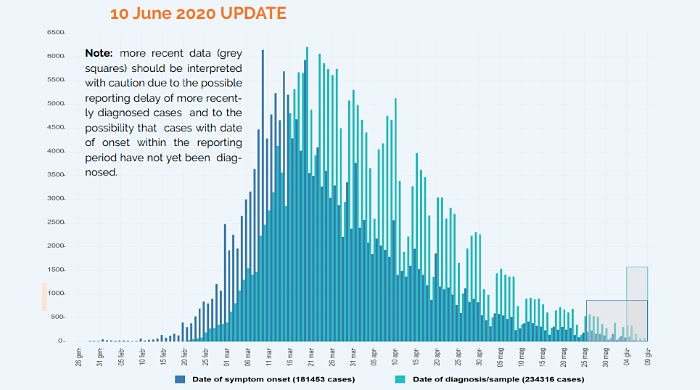The general picture on transmission of the SARS-CoV-2 infection and its impact in Italy remains at a low level of criticality on the whole, according to the latest monitoring report by the Higher Health Institute (ISS) and the health ministry.
The new report regards the week of June 1-7, so after the second phase of reopenings on May 18, 2020.
Time from exposure to diagnosis
As for the time between exposure to the pathogen, diagnosis and the subsequent notification, in many of the cases reported during that week the infection was contracted two-three weeks earlier, so between May 11 and 25, 2020. A general decrease in the number of cases was observed and there were no signs of health services being overloaded.
Nevertheless, a high number of cases continue to be reported in some regions, even though the numbers are decreasing.
This means caution is called for as the circulation of SARS-CoV-2 is still at a significant level in some parts of the country. New cases of infection were diagnosed in almost all of the peninsular during the monitored week.
Covid-19 epidemic is not over
These findings, which in part are due to the intense screening activity being done and investigation of cases, with the identification and monitoring of close contracts, show that the COVID-19 epidemic in Italy is not over. It is essential to stay focused and continue to reinforce the testing-tracing-tracking activities in order to swiftly identify all the potential transmission hotspots and keep controlling the epidemic.
It is also fundamentally important to maintain a high level of awareness among the general population about the fluidity of the epidemiological situation and the importance of continuing to respect all the necessary measures in order to reduce the risks of transmission, such as hand washing and physical distancing.
Conclusions
The lockdown measures have effectively made it possible to control SARS-CoV-2 infection across the national territory, albeit in a situation of persistent widespread transmission of the virus, with widely different incidences among the 21 Italian regions/autonomous provinces.
Transmission signals continue, with new cases diagnosed during the week of monitoring and the possible break out of new hotspots. The report describes an epidemiological situation that is still fluid that calls for rigorous respect of the measures required to reduce the risk of transmission. It is also necessary to maintain a high level of resilience of the regional services in order to facilitate awareness among the population, actively seek out and diagnose potential cases, isolate confirmed cases and put close contacts into quarantine.
Source: Ansa
Fonte Salute.gov.it News
